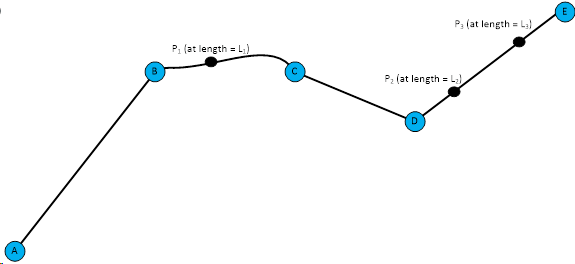ID2D1PathGeometry1::ComputePointAndSegmentAtLength(FLOAT,UINT32,constD2D1_MATRIX_3X2_F*,FLOAT,D2D1_POINT_DESCRIPTION*) method (d2d1_1.h)
Computes the point that exists at a given distance along the path geometry along with the index of the segment the point is on and the directional vector at that point.
Syntax
HRESULT ComputePointAndSegmentAtLength(
FLOAT length,
UINT32 startSegment,
[in, optional] const D2D1_MATRIX_3X2_F *worldTransform,
FLOAT flatteningTolerance,
[out] D2D1_POINT_DESCRIPTION *pointDescription
);
Parameters
length
Type: FLOAT
The distance to walk along the path.
startSegment
Type: UINT
The index of the segment at which to begin walking. Note: This index is global to the entire path, not just a particular figure.
[in, optional] worldTransform
Type: const D2D1_MATRIX_3X2_F*
The transform to apply to the path prior to walking.
flatteningTolerance
Type: FLOAT
The flattening tolerance to use when walking along an arc or Bezier segment. The flattening tolerance is the maximum error allowed when constructing a polygonal approximation of the geometry. No point in the polygonal representation will diverge from the original geometry by more than the flattening tolerance. Smaller values produce more accurate results but cause slower execution.
[out] pointDescription
Type: D2D1_POINT_DESCRIPTION*
When this method returns, contains a description of the point that can be found at the given location.
Return value
Type: HRESULT
The method returns an HRESULT. Possible values include, but are not limited to, those in the following table.
| HRESULT | Description |
|---|---|
| S_OK | No error occurred. |
| E_OUTOFMEMORY | Direct2D could not allocate sufficient memory to complete the call. |
| E_INVALIDARG | One of the inputs was in an invalid range. |
Remarks
A length that is less than 0 or is not a number is treated as if it were 0.
If length is greater than the total length of the path, then the end point of the path is returned.
Example Illustration
Consider this example that explains the value of different parameters returned for the given path geometry. Here are two different scenarios.
Here are two different scenarios.
You want to retrieve the segment at a length L2
You call ComputePointAndSegmentAtLength(Length = L2, startSegment =0). The API returns the following:- D2D1_POINT_DESCRIPTION::point = p2.
- D2D1_POINT_DESCRIPTION::endSegment = 3 (segment DE). This is the value you want.
- D2D1_POINT_DESCRIPTION::lengthToEndSegment = length (AD).
You wants to improve the performance of calculating a point at a given length for animating along a path
Normally, the time intervals would be small and regular, resulting in many animation points per segment. For the purposes of demonstration, however, we will assume the you query ComputePointAndSegmentAtLength three times, with irregularly-spaced lengths L1, L2, L3:You call ComputePointAndSegmentAtLength(Length = L1, startSegment = 0). The API returns the following:
- D2D1_POINT_DESCRIPTION::point = P1.
- D2D1_POINT_DESCRIPTION::endSegment = 1 (segment BC).
- D2D1_POINT_DESCRIPTION::lengthToEndSegment = length (AB).
- D2D1_POINT_DESCRIPTION::point = P2.
- D2D1_POINT_DESCRIPTION::endSegment = 3 (segment DE).
- D2D1_POINT_DESCRIPTION::lengthToEndSegment = length (AD).
- D2D1_POINT_DESCRIPTION::point = P3.
- D2D1_POINT_DESCRIPTION::endSegment = 3 (segment DE).
- D2D1_POINT_DESCRIPTION::lengthToEndSegment =0.
Requirements
| Requirement | Value |
|---|---|
| Minimum supported client | Windows 8 and Platform Update for Windows 7 [desktop apps | UWP apps] |
| Minimum supported server | Windows Server 2012 and Platform Update for Windows Server 2008 R2 [desktop apps | UWP apps] |
| Target Platform | Windows |
| Header | d2d1_1.h |
| DLL | D2d1.dll |
See also
Feedback
Coming soon: Throughout 2024 we will be phasing out GitHub Issues as the feedback mechanism for content and replacing it with a new feedback system. For more information see: https://aka.ms/ContentUserFeedback.
Submit and view feedback for